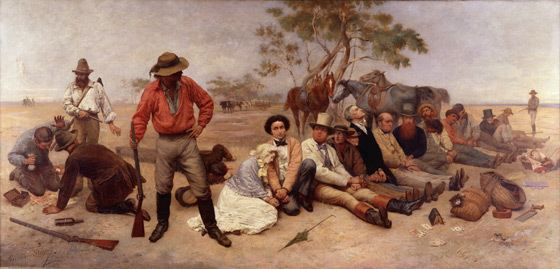 | ||
The legend of ben hall an australian bushranger movie by matthew holmes
Bushrangers were originally escaped convicts in the early years of the British settlement of Australia who had the survival skills necessary to use the Australian bush as a refuge to hide from the authorities. By the 1820s, the term "bushranger" had evolved to refer to those who abandoned social rights and privileges to take up "robbery under arms" as a way of life, using the bush as their base.
Contents
- The legend of ben hall an australian bushranger movie by matthew holmes
- Australian bushrangers
- Etymology
- History
- Convict era
- 1850s gold rush era
- 1860s
- 1870s to 1900s
- Public perception
- Legacy
- Popular culture
- References

Bushranging thrived during the gold rush years of the 1850s and 1860s when the likes of Ben Hall, Frank Gardiner and John Gilbert led notorious gangs in the country districts of New South Wales. These "Wild Colonial Boys", mostly Australian-born sons of convicts, were roughly analogous to British "highwaymen" and outlaws of the American Old West, and their crimes typically included robbing small-town banks and coach services. In other infamous cases, such as that of Dan Morgan, the Clarke brothers, and Australia's best-known bushranger, Ned Kelly, numerous policemen were murdered. The number of bushrangers declined due to better policing and improvements in rail transport and communication technology, such as telegraphy. Kelly's capture and execution in 1880 effectively represented the end of the bushranging era.
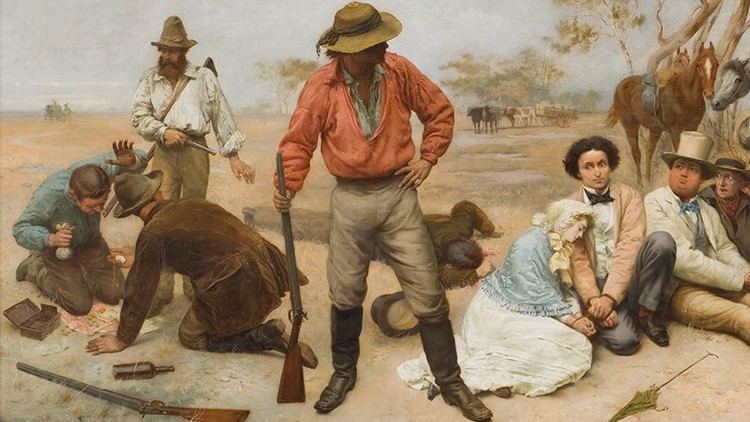
Bushranging exerted a powerful influence in Australia, lasting for almost a century and covering much of the continent. Its origins in a convict system bred a unique kind of desperado, frequently with an Irish political background. Native-born bushrangers also expressed nascent Australian nationalist views and are recognised as "the first distinctively Australian characters to gain general recognition." As such, many bushrangers became folk heroes and symbols of rebellion against the authorities. Firmly entrenched in Australian folklore, bushrangers have inspired many works in the arts, including bush ballads, plays and films.
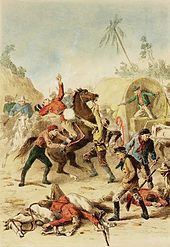
Australian bushrangers
Etymology

The first recorded use of the term "bushranger" appears in a February 1805 issue of The Sydney Gazette, which reports that a cart had been stopped by three men "whose appearance sanctioned the suspicion of their being bushrangers". From this time onwards, the term was used to denote criminals who attacked people on the roads or in the bush. John Bigge described bushranging in 1821 as "absconding in the woods and living upon plunder and the robbery of orchards." Charles Darwin likewise recorded in 1835 that a bushranger was "an open villain who subsists by highway robbery, and will sooner be killed than taken alive".
History
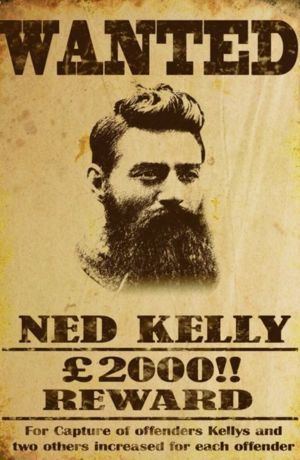
Over 2,000 bushrangers are estimated to have roamed the Australian countryside, beginning with the convict bolters and drawing to a close after Ned Kelly's last stand at Glenrowan.
Convict era
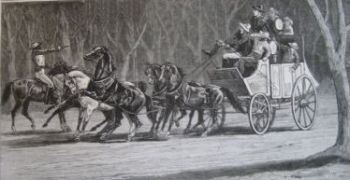
Bushranging began soon after British colonisation with the establishment of Sydney, New South Wales as a penal colony in 1788. The majority of early bushrangers were convicts who had escaped prison, or from the properties of landowners to whom they had been assigned as servants. These bushrangers, also known as "bolters", preferred the hazards of wild, unexplored bushland surrounding Sydney to the deprivation and brutality of convict life. The first bushranger gang, led by African convict John Caesar, robbed settlers for food, and kept a tempestuous alliance with Aboriginal resistance fighters during Pemulwuy's War. While other bushrangers would go on to fight alongside Indigenous Australians in frontier conflicts with the colonial authorities, the Government tried to bring an end to any such collaboration by rewarding Aborigines for returning convicts to custody. Aboriginal trackers would play a significant role in the hunt for bushrangers.
Colonel Godfrey Mundy described convict bushrangers as "desperate, hopeless, fearless; rendered so, perhaps, by the tyranny of a gaoler, of an overseer, or of a master to whom he has been assigned." Edward Smith Hall, editor of early Sydney newspaper The Monitor, agreed that the convict system was a breeding-ground for bushrangers due to its savagery, with starvation and acts of torture being rampant. "Liberty or Death!" was the cry of convict bushrangers, and in large numbers they roamed beyond Sydney, some hoping to reach China, which was commonly believed to be connected by an overland route. Bolters such as the Norfolk Island mutineers seized boats and set sail for foreign lands, but most were hunted down and brought back to Australia. Others attempted to inspire an overhaul of the convict system, or simply sought revenge on their captors. This latter desire found expression in the convict ballad "Jim Jones at Botany Bay", in which Jones, the narrator, plans to join bushranger Jack Donahue and "gun the floggers down".
Convict bushrangers were particularly prevalent in the penal colony of Van Diemen's Land, established in 1803. The island's most powerful bushranger, the self-styled "Lieutenant Governor of the Woods", Michael Howe, led a gang of up to one hundred members "in what amounted to a civil war" with the colonial government. His control over large swathes of the island prompted elite land owners from Hobart and Launceston to collude with him, and for six months in 1815, Lieutenant-Governor Thomas Davey, fearing a convict uprising, declared martial law in an effort to suppress Howe's influence. He was killed by soldiers in 1818. Other notorious Vandemonian bolters include the cannibal serial killers Thomas Jeffries and Alexander Pearce.
1850s: gold rush era
The bushrangers' heyday was the Gold Rush years of the 1850s and 1860s as the discovery of gold gave bushrangers access to great wealth that was portable and easily converted to cash. Their task was assisted by the isolated location of the goldfields and a police force decimated by troopers abandoning their duties to join the gold rush.
George Melville was hanged in front of a large crowd for robbing the McIvor gold escort near Castlemaine in 1853.
1860s
Bushranging numbers flourished in New South Wales with the rise of the colonial-born sons of poor, often ex-convict squatters who were drawn to a more glamorous life than mining or farming.
Much of the activity in this era was in the Lachlan Valley, around Forbes, Yass and Cowra.
Frank Gardiner, John Gilbert and Ben Hall led the most notorious gangs of the period. Other active bushrangers included Dan Morgan, based in the Murray River, and Captain Thunderbolt. Thunderbolt was the most successful Australian bushranger, if bushranging longevity is the benchmark, as he bushranged across northern New South Wales for six-and-a-half years until shot near Uralla in 1870. With his death, the New South Wales bushranging epidemic of the 1860s officially ended.
1870s to 1900s
The increasing push of settlement, increased police efficiency, improvements in rail transport and communications technology, such as telegraphy, made it more difficult for bushrangers to evade capture.
Among the last bushrangers was the Kelly Gang led by Ned Kelly, who were captured at Glenrowan in 1880, two years after they were outlawed.
In 1900 the indigenous Governor Brothers terrorised much of northern New South Wales.
Public perception
In Australia, bushrangers often attract public sympathy (cf. the concept of social bandits). In Australian history and iconography bushrangers are held in some esteem in some quarters due to the harshness and anti-Catholicism of the colonial authorities whom they embarrassed, and the romanticism of the lawlessness they represented. Some bushrangers, most notably Ned Kelly in his Jerilderie letter, and in his final raid on Glenrowan, explicitly represented themselves as political rebels. Attitudes to Kelly, by far the most well-known bushranger, exemplify the ambivalent views of Australians regarding bushranging. Victoria's state cricket team adopted 'Bushrangers' as their team nickname in honour of those such as the Kelly Gang, who lived in the Victorian bush.
Legacy
The impact of bushrangers upon the areas in which they roamed is evidenced in the names of many geographical features in Australia, including Kelly Country, Thunderbolts Way, Brady's Lookout, Mount Tennent and Ward's Mistake.
Popular culture
Early plays about bushrangers include David Burn's The Bushrangers (1829), William Leman Rede's Faith and Falsehood; or, The Fate of the Bushranger (1830), The Bushrangers; or, Norwood Vale (1834) by Henry Melville, and The Bushrangers; or, The Tregedy of Donohoe (1835) by Charles Harpur.
Tom Roberts, one of the leading figures of the Heidelberg School (also known as Australian Impressionism), depicted bushrangers in some of his historical paintings, including In a corner on the Macintyre (1894) and Bailed Up (1895), both set in Inverell, the area where Captain Thunderbolt was once active.
Although not the first Australian film with a bushranging theme, The Story of the Kelly Gang (1906)—the world's first feature-length narrative film—is regarded as having set the template for the genre. On the back of the film's success, its producers released one of two 1907 film adaptations of Boldrewood's Robbery Under Arms (the other being Charles MacMahon's version). Entering the first "golden age" of Australian cinema (1910–12), director John Gavin released two fictionalised accounts of real-life bushrangers: Moonlite (1910) and Thunderbolt (1910). The genre's popularity with audiences led to a spike of production unprecedented in world cinema. Dan Morgan (1911) is notable for portraying its title character as an insane villain rather than a figure of romance. Ben Hall, Frank Gardiner, Captain Starlight, and numerous other bushrangers also received cinematic treatments at this time. Alarmed by what they saw as the glorification of outlawery, state governments imposed a ban on bushranger films in 1912, effectively removing "the entire folklore relating to bushrangers ... from the most popular form of cultural expression." It is seen as a major reason for the collapse of a booming Australian film industry. One of the few Australian films to escape the ban before it was lifted in the 1940s is the 1920 adaptation of Robbery Under Arms. Also during this lull appeared American takes on the bushranger genre, including The Bushranger (1928), Stingaree (1934) and Captain Fury (1939).
Ned Kelly (1970) starred Mick Jagger in the title role. Dennis Hopper portrayed Dan Morgan in Mad Dog Morgan (1976). More recent bushranger films include Ned Kelly (2003), starring Heath Ledger, The Proposition (2005), written by Nick Cave, The Outlaw Michael Howe (2013), and The Legend of Ben Hall (2016).
